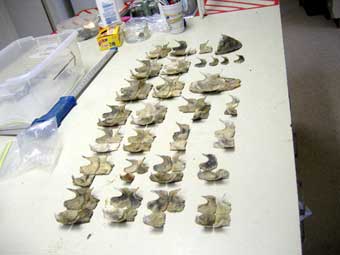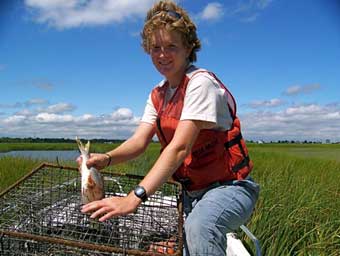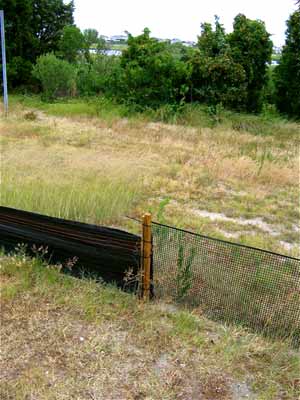 |
Abstracts of Papers
Presented by Wetlands Institute staff at the
4th National Symposium on the Ecology, Status, and Conservation of the Diamondback Terrapin,
Arlington Echo Outdoor Education Center, Millersville, MD, August 10–12, 2007
The Threat of Ghost Traps to Diamondback Terrapins in New Jersey
Kaitlin Mattos and Roger Wood

The Wetlands Institute, 1075 Stone Harbor Boulevard, Stone Harbor, NJ 08247, USA
 |


Terrapin skeletal remains extracted from a ghost trap
that had over 40 dead terrapins |
|
 |
The number-one killer of diamondback terrapins in New Jersey is incidental capture and drowning in commercial crab traps, with deaths estimated at 14,000–15,000 per year in the mid-1990s. Many of these deaths can be attributed to ghost crab traps, which are derelict traps that have been lost or abandoned and are no longer being checked and emptied of their catches. Over a 3-week period I located and removed 41 ghost traps from the salt marsh creeks and sounds near the Wetlands Institute. These ghost traps contained at least 41 dead terrapins and various other organisms. This source of terrapin mortality could be greatly reduced if regulations to prevent bycatch were strengthened. Terrapins and other salt marsh animals would also benefit from the organization of large community trap removal efforts.
Links between Sex and the Frequency and Type of
Scute Anomalies in Diamondback Terrapins (Malaclemys terrapin terrapin)
Margaret Perry and Patrick Baker

The Wetlands Institute, 1075 Stone Harbor Boulevard, Stone Harbor, NJ 08247, USA
 |


Meg Perry, 2007 Student Researcher, baiting a crab trap
to catch terrapins to assess their carapace for
shell anomalies |
|
Scute anomalies are irregularities in the scales covering the bones of a turtle's shell. Previous research has shown that high incubation temperatures increase the frequency of scute anomalies in the diamondback terrapin (Malaclemys terrapin terrapin). Since diamondback terrapins have temperature-dependent sex determination, with higher incubation temperatures producing females, it seems likely that female terrapins have more scute anomalies than males. Adult and juvenile male and female diamondback terrapins were trapped in two salt marsh creeks in southern New Jersey during June, July, and September 2007. The type and frequency of scute anomalies in these turtles were recorded and compared between the sexes. The overall frequency of anomalies appears to be higher in females than males, but when different types of anomalies are considered separately there is no consistent relationship between sex and anomaly frequency. Some anomalies appear with equal frequency in males and females, while others show evidence of a correlation with sex. It appears that incubation temperature may influence different types of anomalies to different degrees, perhaps because some anomalies are genetically determined while others are developmental in origin.
Use of Roadway Fencing as a Means of Preventing Diamondback Terrapin
(Malaclemys terrapin terrapin) Mortality from Vehicle Strikes In New Jersey.
Ilene Eberly and Roger Wood

The Wetlands Institute, 1075 Stone Harbor Blvd, Stone Harbor, NJ, 08247, USA
 |


Silt fence material shown left
and Tenax fence material, right |
|
 |
Every summer along the Atlantic coast of southern New Jersey, hundreds of gravid diamondback terrapins (Malaclemys terrapin terrapin) are run over and killed by motor vehicles as they cross roadways in search of nest sites. In view of encouraging preliminary results from a pilot study conducted in 2004, a large-scale barrier fencing project was developed during the summer of 2005. Silt fencing was installed along either side of Stone Harbor Blvd. (approximately 0.9 km = 1.77 km total) to provide an effective barrier that prevents terrapins from wandering onto heavily trafficked roads. In addition, GPS data of terrapin road kills indicated that certain stretches of coastal roads are “hot spots” of unusually heavy terrapin mortality. From 2005 to 2006, the barrier fence was installed along a section of Stone Harbor Blvd. reducing the number of terrapin road kills by approximately 85%–83%, from 46 (in 2004) to only 6 (in 2005) and 7 (in 2006). In 2006 a 0.3 km section of a promising new fencing material, “Tenax” (a thick, mesh material), was installed to determine its durability in harsh coastal conditions over the course of a year. In the summer of 2007 the fencing project was expanded to include an additional “hotspot” along a 2.28 km section of Avalon Blvd. We expect that the newly fenced roadways will further reduce terrapin mortality as was seen along Stone Harbor Blvd.
Return to Abstracts Index
|
 |
![]()
![]()
![]()


